Staphylococcus aureus Overview
Staphylococcus aureus, commonly known as S. aureus, is a Gram-positive, facultative anaerobic bacterium belonging to the Staphylococcaceae family. Widely distributed in the environment and often found in colonizing the skin and mucous membranes of humans, S. aureus is a versatile microorganism with significant implications for both health and disease. As a crucial focus in microbiological studies, it serves as a sentinel organism due to its prevalence in various settings.
Must Read the detailed topic: Exploring Staphylococcus Aureus | What You Must Need to Know
The distinguishing features of S. aureus include its spherical, Gram-positive cells arranged in clusters. While many strains coexist harmlessly as part of the human microbiota, certain pathogenic strains of S. aureus can lead to a spectrum of infections, ranging from skin and soft tissue infections to more severe conditions such as bacteremia, pneumonia, and endocarditis.
The ability of S. aureus to produce a variety of virulence factors, including toxins, enzymes, and surface adhesins, contributes to its pathogenicity. This dual nature of being a commensal bacterium and a potential pathogen underscores the significance of in-depth research on Staphylococcus aureus to better understand its behavior, transmission, and mechanisms of infection.
Isolation Techniques
Sample Collection
Types of Samples
- Clinical Specimens: S. aureus is often isolated from clinical specimens, including wound swabs, blood cultures, and respiratory samples, obtained from patients exhibiting various infections, such as skin and soft tissue infections, bacteremia, and respiratory infections.
- Nasal Swabs: As S. aureus is a common colonizer of the nasal passages, nasal swabs are frequently collected for screening and surveillance purposes.
- Environmental Surfaces: Environmental surfaces in healthcare settings, homes, or public spaces may be sampled to assess the presence of S. aureus, especially methicillin-resistant strains (MRSA).
Enrichment Media
Enrichment media play a crucial role in supporting the growth of S. aureus. Commonly used enrichment media include:
- Tryptic Soy Broth (TSB): TSB provides a nutrient-rich environment suitable for the growth of S. aureus and is often employed in initial enrichment steps.
- Brain Heart Infusion Broth (BHI): BHI is another enriched medium that supports the growth of S. aureus, particularly in clinical specimens.
- Mannitol Salt Broth (MSB): MSB is a selective medium that contains high salt concentration, promoting the growth of Staphylococci, including S. aureus.
Isolation on Solid Media
Isolating Staphylococcus aureus on solid media involves the use of specific agar formulations designed to support its growth and facilitate distinctive colony characteristics. Various solid media are employed for this purpose, each offering unique advantages in terms of selectivity and differential features.
Tryptic Soy Agar (TSA)
Tryptic Soy Agar (TSA) is a versatile medium used to cultivate and isolate various microorganisms, including Staphylococcus aureus. It provides a nutrient-rich environment with the following characteristics:
Colony Morphology
- Color: Staphylococcus aureus colonies on TSA typically exhibit a golden-yellow color.
- Appearance: Colonies present as circular, smooth, and convex.
- Size: Ranging from small to medium-sized colonies.
- Texture: Colonies may appear moist or glistening.
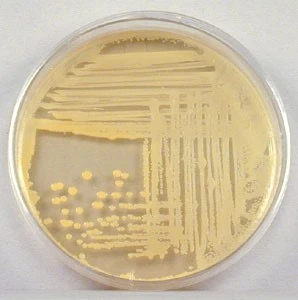
Nutrient Agar
On Nutrient Agar, Staphylococcus aureus displays characteristic colony morphology and growth patterns, providing key features for identification:
Colony Morphology
- Color: Staphylococcus aureus colonies on Nutrient Agar often present as golden-yellow.
- Appearance: Colonies appear smooth, circular, and convex.
- Size: Ranging from small to medium-sized colonies.
- Texture: Colonies may exhibit a moist or glistening appearance.
Growth Patterns
- Growth Rate: Staphylococcus aureus exhibits robust growth on Nutrient Agar, reflecting its fast-doubling time and the provision of essential nutrients in the medium.
- Colonial Characteristics: Individual colonies may coalesce, forming a continuous lawn of growth, especially in confluent cultures.
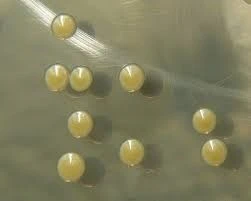
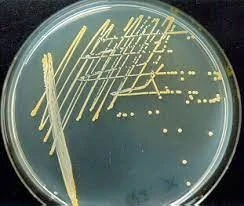
Figure 2 S. aureus Colony Morphology on Nutrient Agar – Source: Bacteria in photos
Blood Agar
On Blood Agar, Staphylococcus aureus demonstrates distinctive colony morphology and growth patterns, providing key features for identification:
Colony Morphology
- Color: Staphylococcus aureus colonies typically exhibit a golden-yellow hue on Blood Agar.
- Appearance: Colonies appear smooth, circular, and convex.
- Size: Ranging from small to medium-sized colonies.
- Texture: The colonies often present a moist or glistening appearance.
Hemolysis
- Beta-Hemolysis: Staphylococcus aureus is known for its beta-hemolytic activity, leading to a clear zone surrounding colonies due to the complete lysis of red blood cells.
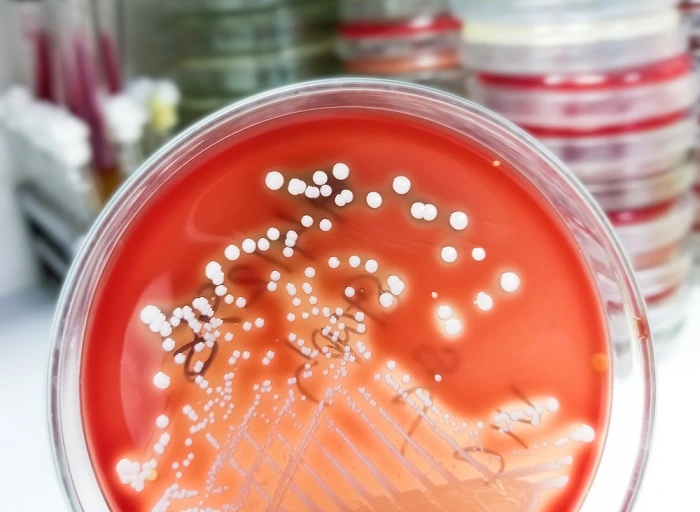
Mannitol Salt Agar (MSA)
Mannitol Salt Agar (MSA) serves as an effective medium for isolating Staphylococcus aureus, offering specific characteristics for identification:
Colony Morphology
- Color: Staphylococcus aureus colonies on MSA typically display a distinctive yellow color.
- Appearance: Colonies present as smooth and convex, with a medium-sized profile.
- Texture: The colonies may exhibit a slightly moist or mucoid texture.
- Size: Small-sized colonies.
Mannitol Fermentation
- Positive Reaction: Staphylococcus aureus is capable of fermenting mannitol present in the agar, leading to the production of acid.
- Color Change: A change in the medium’s color to yellow indicates the positive fermentation, providing a visual indicator of Staphylococcus aureus growth.
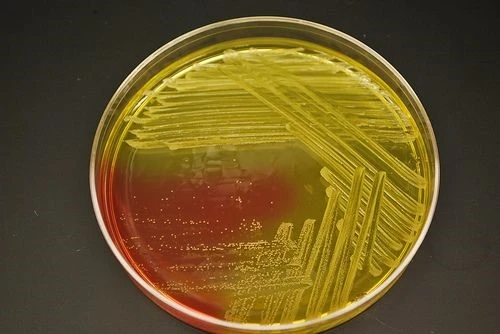
CHROMagar™ Staph Aureus
CHROMagar™ Staph Aureus is a specialized medium designed for the selective isolation and identification of Staphylococcus aureus, offering distinct characteristics for efficient identification:
Colony Morphology
- Color: Staphylococcus aureus colonies on CHROMagar™ typically appear mauve or pink.
- Appearance: Colonies exhibit a smooth and round morphology.
- Size: Colonies may vary in size from small to medium sized.
Enzymatic Activity
- Chromogenic Substrate Utilization: CHROMagar™ contains chromogenic substrates that react with specific enzymes produced by Staphylococcus aureus.
- Color Change: The color change in colonies is indicative of enzymatic activity, aiding in the rapid and accurate identification of Staphylococcus aureus.
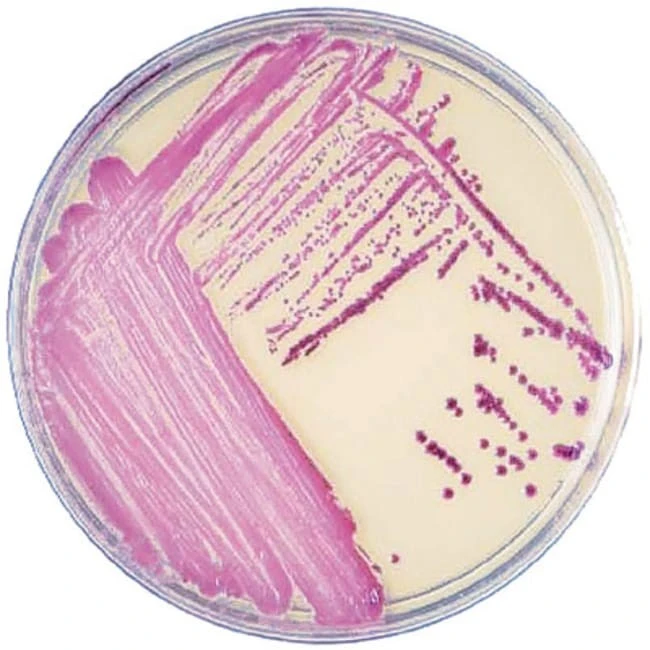
Microscopic Examination
1. Gram Staining
- Staphylococcus aureus, as a Gram-positive bacterium, exhibits a violet/purple color under the microscope after Gram staining.
2. Morphological Characteristics Under the Microscope
- Staphylococcus aureus is characterized by its spherical or cocci morphology under microscopic examination.
- Cells often occur in grape-like clusters, reflecting the typical staphylococcal arrangement.
- Cell size estimation through microscopic examination typically shows cocci with diameters ranging around 0.5 to 1.5 micrometers.
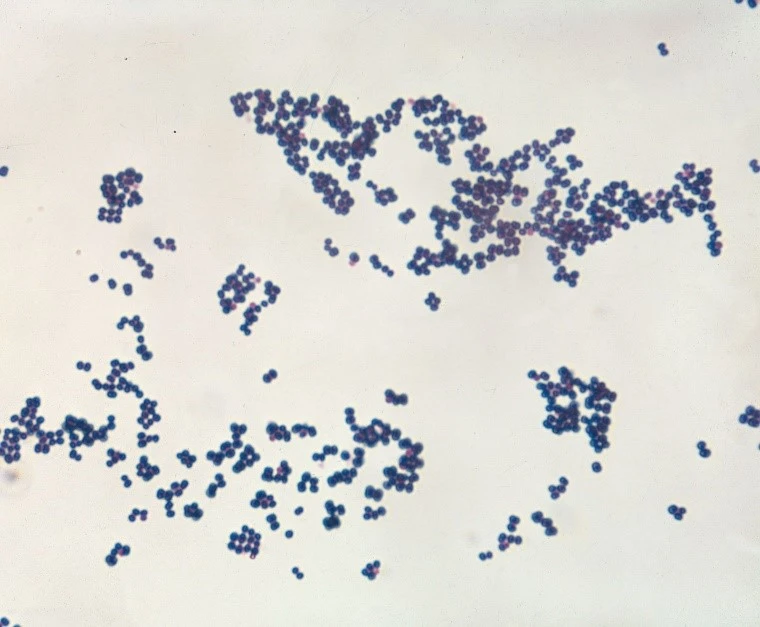
Biochemical Tests
1. Coagulase Test
- Staphylococcus aureus is often identified through the Coagulase test, where the formation of clots indicates a positive reaction, distinguishing it from other staphylococci (Blood plasma agglutination)
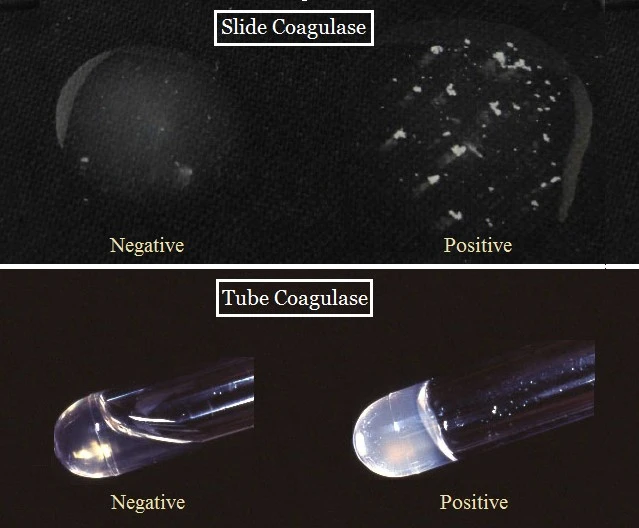
2. Catalase Test
- Staphylococcus aureus is catalase-positive, exhibiting rapid bubble formation upon the addition of hydrogen peroxide.
3. Mannitol Salt Agar (MSA) Fermentation
- Staphylococcus aureus ferments mannitol, leading to a change in the color of MSA to yellow, indicating positive fermentation.
4. Blood Hemolysis Test
- Staphylococcus aureus displays beta-hemolysis on blood agar, characterized by a clear zone around colonies due to complete red blood cell lysis.
5. Oxidase Test
- Staphylococcus aureus is oxidase-negative, showing no color change in response to oxidase reagents.
6. DNase Test
- Staphylococcus aureus produces DNase, as indicated by the clearing around colonies on DNase agar after the addition of hydrochloric acid.
7. Nitrate Reduction Test
- Staphylococcus aureus typically exhibits negative results in the nitrate reduction test, showing no color change in the presence of nitrate reagents.
Biochemical Profile of Staphylococcus aureus
| BASIC CHARACTERISTICS | PROPERTIES (S. AUREUS) |
| Capsule | Non-capsulated |
| Gram Staining | Positive (+ve) |
| Oxidase | Negative (-ve) |
| Catalase | Positive (+ve) |
| Coagulase | Positive (+ve) |
| Citrate | Positive (+ve) |
| Gas | Negative (-ve) |
| Flagella | Non-flagellated |
| Motility | Non-motile |
| Indole | Negative (-ve) |
| H2S | Negative (-ve) |
| MR (Methyl Red) | Positive (+ve) |
| VP (Voges Proskauer) | Positive (+ve) |
| Nitrate Reduction | Positive (+ve) |
| TSIA (Triple Sugar Iron Agar) | Alkaline/Alkaline, No Gas (-ve) |
| Urease | Positive (+ve) |
| Hemolysis | Beta-hemolytic |
| Growth in KCN | Negative (-ve) |
| Gelatin Hydrolysis | Positive (+ve) |
| OF (Oxidative-Fermentative) | Fermentative |
| Pigment | Positive (+ve) – Golden/Yellow |
| PYR | Negative (-ve) |
| Shape | Cocci (Spherical) |
| Spore | Non-Sporing |
Sugar Fermentation Profile of Staphylococcus aureus
| Sugar/Substance | Result |
| Lactose | Positive (+ve) |
| Fructose | Positive (+ve) |
| Glactose | Positive (+ve) |
| Glucose | Positive (+ve) |
| Maltose | Positive (+ve) |
| Sucrose | Positive (+ve) |
| Glycerol | Variable |
| Mannose | Positive (+ve) |
| Mannitol | Positive (+ve) |
| Sorbitol | Negative (-ve) |
| Malonate | Variable |
| Tartrate | Negative (-ve) |
| Trehalose | Positive (+ve) |
| Ribose | Positive (+ve) |
| Xylose | Negative (-ve) |
| Arabinose | Negative (-ve) |
| DNase | Positive (+ve) |
| Arabitol | Negative (-ve) |
| Cellobiose | Negative (-ve) |
| Raffinose | Negative (-ve) |
| Salicin | Negative (-ve) |
Enzymatic Reactions Profile of Staphylococcus aureus
| Enzyme/Substance | Result |
| Lipase | Positive (+ve) |
| Arginine Dihydrolase | Positive (+ve) |
| Ornithine Decarboxylase | Negative (-ve) |
| Acetoin Production | Positive (+ve) |
| Alkaline Phosphatase | Positive (+ve) |
| Acetate Utilization | Negative (-ve) |
| Hyalurodinase | Positive (+ve) |
Molecular Techniques for Staphylococcus aureus Identification
Polymerase Chain Reaction (PCR)
Polymerase Chain Reaction (PCR) is a powerful molecular technique utilized for the amplification of specific DNA sequences, and various target genes are employed in the identification of Staphylococcus aureus.
Target Genes for E. coli Identification
- 16S rRNA Gene: The 16S ribosomal RNA gene, a common target for bacterial identification, serves as a valuable marker for Staphylococcus aureus. This gene contains conserved regions for general bacterial identification and variable regions for species-specific identification, with specific primers designed for Staphylococcus aureus DNA amplification.
- nuc Gene (Thermonuclease): The nuc gene encodes for thermonuclease, an enzyme characteristic of Staphylococcus aureus. Detection of this gene is indicative of the presence of Staphylococcus aureus.
- spa Gene (Staphylococcal Protein A): The spa gene, associated with Staphylococcal Protein A, is another target for Staphylococcus aureus identification. This gene is known for its variability and is often used in typing studies.
- coa Gene (Coagulase): The coa gene, responsible for coagulase production, is utilized as a target for Staphylococcus aureus identification. Coagulase is a key virulence factor produced by this bacterium.

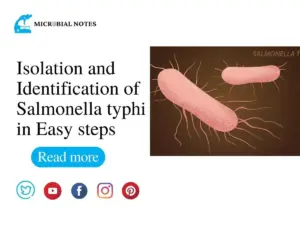




Asking questions are really pleasant thing if you are not
understanding something completely, however this paragraph presents pleasant
understanding even.
Quality articles or reviews is the secret to invite the visitors to pay a
visit the web site, that’s what this web
site is providing.
This page is extraordinary. The magnificent data uncovers the proprietor’s responsibility. I’m stunned and sit tight for additional such marvelous posts.
If some one wishes to be updated with most up-to-date technologies after that he
must be visit this website and be up to date everyday.
Usually I do not read article on blogs however I would like to say that this writeup very compelled me to take a look at and do so Your writing taste has been amazed me Thanks quite nice post
I do trust all the ideas youve presented in your post They are really convincing and will definitely work Nonetheless the posts are too short for newbies May just you please lengthen them a bit from next time Thank you for the post
I might like this blog, my brother said, and he was entirely right. Seeing this post made my day. You are not aware of the amount of time I invested in finding this information.
I do not even know how I ended up here but I thought this post was great I dont know who you are but definitely youre going to a famous blogger if you arent already Cheers
Its like you read my mind You appear to know a lot about this like you wrote the book in it or something I think that you could do with some pics to drive the message home a little bit but instead of that this is fantastic blog An excellent read I will certainly be back